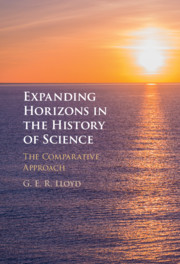Figures 5.1 and 5.2 give the simplest forms of the epicyclic and eccentric models respectively. In Figure 5.1 the planet (or sun or moon) (P) moves round the circumference of an epicycle, whose centre (C) itself moves round the circumference of what is called the deferent circle whose centre (E) is the earth. The sense of the movement of a planet on its epicycle is the same as that of the deferent circle, while for the sun and moon, which do not exhibit retrogradation, the two circles move in opposite senses.

Figure 5.1 Epicyclic motion

Figure 5.2 Eccentric motion
In Figure 5.2 the planet, sun or moon (P) moves round the circumference of a circle whose centre (O) is at some distance from the earth (E).
Figure 5.3 shows the simplest case where the eccentric and epicyclic models give rise to the same phenomena. When the radius of the deferent circle (CE) is equal to that of the eccentric circle (RO) and the radius of the epicycle (RC) is equal to the eccentricity (OE), then if the angular velocities are such that R and E remain vertices of a parallelogram (CROE and C′R′OE) the two models give equivalent results.

Figure 5.3 The simplest case of the equivalence of eccentric and epicyclic motions
Figure 5.4 illustrates how in the case of the sun an eccentric model can represent the inequality of the four seasons measured by the solstices and equinoxes, and Figure 5.5 shows how an epicyclic model can represent the retrogradation of a planet.

Figure 5.4 The inequality of the seasons explained by the eccentric hypothesis

Figure 5.5 The epicyclic model used to explain the retrogradation of the planets
For a clear exposition of these models and how they compare with the way the phenomena would be represented in a Copernican, heliocentric system the reader may be referred to Reference NeugebauerNeugebauer 1957: ch. 6.








